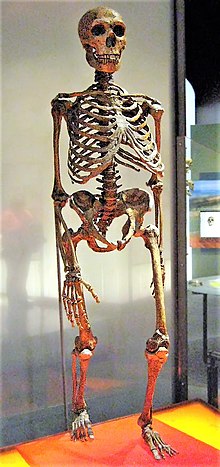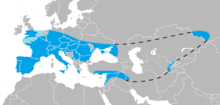
Back Neanderdaller Afrikaans Neandertaler ALS نياندرتال Arabic نياندرطال ARY Homo neanderthalensis AST Neandertal insanı Azerbaijani نئاندرتال AZB Neandertaler BAR Neandertal BCL Неандэрталец Byelorussian
| Neanderthal Temporal range: Pleistocene
| |
|---|---|

| |
| Skeleton in the American Museum of Natural History, Manhattan | |
| Scientific classification | |
| Kingdom: | |
| Phylum: | |
| Class: | |
| Order: | |
| Family: | |
| Genus: | |
| Species: | |

| |
| Neanderthal range | |
The Neanderthal,[1] a species of the genus Homo, was a near relative of our own species. Its scientific name is Homo neanderthalensis or Homo sapiens neanderthalensis.[2]
Neanderthal fossils were only found in Europe, Asia Minor and up to central Asia. The first fossil was found in a limestone quarry near Düsseldorf: One of the workers found part of a skeleton, in a valley now called Neandertal. Experts Johann Carl Fuhlrott and Hermann Schaaffhausen said the bones belonged to an older form of modern humans. These bones are known as Neanderthal 1 today.
Recent research suggests Neanderthals became extinct about 40,000 years ago.[3] Earlier research had suggested a later date; the problem is the dating of the archaeological sites where their remains have been found.
Neanderthals perhaps evolved from Homo heidelbergensis and split off (last common ancestor) from modern humans between 700,000 and 300,000 years ago.[4]
Neanderthals used to be classified as a subspecies of modern humans (Homo sapiens neanderthalensis). Now, they are usually classified as a separate human species (Homo neanderthalensis).
Neanderthal remains have been found in most of Europe south of land covered by ice including the south coast of Great Britain. Finds have also been made outside of Europe in the Zagros Mountains and in the Levant.
- ↑ The word is pronounced without the 'h', and sometimes spelled 'Neandertal'. English pronunciation: /niːˈændərθɑːl/, also with /neɪ-/, and /-tɑːl/
- ↑ Tattersall I, Schwartz JH (1999). "Hominids and hybrids: the place of Neanderthals in human evolution". Proc. Natl. Acad. Sci. U.S.A. 96 (13): 7117–9. Bibcode:1999PNAS...96.7117T. doi:10.1073/pnas.96.13.7117. PMC 33580. PMID 10377375. Available on-line
- ↑ Amos, Jonathan 2013. Last-stand Neanderthals queried. BBC News Science/Environment. [1]
- ↑ Ker Than 2006. Scientists decode Neanderthal genes Archived 2007-01-03 at the Wayback Machine
